Lying in the northwest of Vietnam, not far from the border with China, Sapa is an absolute treat to visit. Sapa Vietnam lies amidst beautiful mountains and is surrounded by brilliant green terraced rice fields – well, that is if you visit at the right time of year!
While the scenery is stunning, Sapa is just as renowned for its intoxicating cultural makeup. The tiny villages dotted upon the hillsides are home to a diverse array of ethnic minorities, each with their own rich culture and customs.
Combining both culture and natural beauty into one enticing package, Sapa is definitely worth visiting if you have the chance. While its remote location does make it a bit of a pain to get to, it’s also what has preserved the scenic beauty and rich cultural heritage for so long!
Here is our travel guide to Sapa Vietnam with everything you need to know before your visit!
*When looking for the best price and biggest selection of hotels in Sapa check prices on Booking.com, we’ve found they are the best option and have a great cancelation policy.*
Sapa Vietnam Travel Guide
With each passing year, it gets a little bit easier to travel to Sapa and Northern Vietnam, but it is still one of the more challenging destinations to reach due to its remote location. That same remoteness is much of the appeal to most visitors.
Here in Sapa, you’ll have a chance to see rural life and experience cultures that are unique to this part of the world. Below is our first-hand guide from our time spent exploring Sapa, Vietnam.
Jump to Info on Sapa:
- How to get to Sapa – Hanoi to Sapa
- Things to do in Sapa
- Trekking in Sapa Vietnam
- Weather in Sapa
- Rice Terraces in Sapa
- Sapa Cultures and history
- Tips and Sapa FAQ
How to Get to Sapa Vietnam
As you might have gathered, Sapa lies in quite a remote region, so getting there can be a bit of a challenge – although you surely won’t regret it! While some routes are easier than others, you will need to plan carefully so that you don’t end up spending too much time in transit.
Hanoi to Sapa By train
The easiest, most convenient, and most popular way of getting to Sapa Vietnam is by train. The journey usually takes around eight hours if you’re coming from Hanoi. However, this only takes you to Lao Cai Railway Station; from there, you need to take a shuttle bus to reach Sapa.
There are a number of different options when it comes to the train; it’s a good idea to book in advance, as during the summer months and at weekends, it can get quite full, and the nicer cabins may get booked out. Many people decide to take the overnight express train to save on accommodation and sleep throughout the journey.
When booking your train tickets, it’s worthwhile going to the station yourself, as you may find that some travel agencies don’t always provide you with what you booked! There are a number of ‘classes’ for you to choose from; prices vary accordingly, depending on whether you booked a ‘soft bed’ with a private railway company or a ‘hard bed’ with the national Vietnam Railways. You can also choose to stay in a private cabin or a four or six-bed bunk compartment.
Prices also fluctuate depending on what time of year you go; they increase substantially during national holidays. When taking the train, you probably want to book one of the nicer options as they can be a bit grimy.
As you can see, the price of the train really depends on what option you choose. Tickets start from $18 and go all the way up to over $100 if you choose the really nice cabin!
Once you arrive at Lao Cai Railway Station, you need to take a shuttle bus to Sapa, Vietnam. Make sure to negotiate to avoid being overcharged; the fair price is around 50,000 Dong.
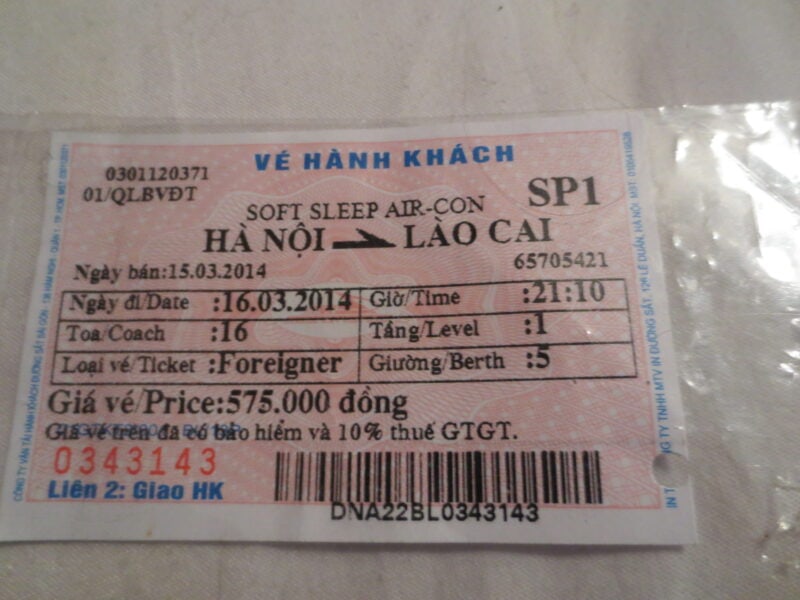
Hanoi to Sapa By bus
Another option is to take the bus to Sapa Vietnam. With the bus, the journey time is slightly shorter; it usually takes around six hours from Hanoi. As the terminus is in the center of town, you don’t have to mess around finding a shuttle bus.
Buses depart at all times of the day from Hanoi. Prices fluctuate depending on if you take one of the luxury lines or one of the more basic ones; some even drop you at wherever you have arranged to stay in Sapa.
Prices range from $11 for the cheaper bus lines up to around $20 or more for the nicer ones.
While you do pass some lovely scenery on the way to Sapa Vietnam, and the buses are certainly comfortable, the mountain roads can be quite windy and dangerous. You may be better off taking the longer but safer train journey after all!
Things to do in Sapa Vietnam
There are loads of great things to see and do in Sapa Vietnam. Visitors usually love all that the charming town has to offer – these suggestions only skim the surface!
1. Trek to the local villages
Trekking to some of the nearby local villages is a must when in Sapa, you’ll pass some absolutely gorgeous scenery. Once you arrive, you’ll be immersed in the hill tribes’ culture and customs and come away richer for the experience. The Cat Cat Village is particularly popular amongst tourists, as you get to see how the Hmong villagers farm the valley and produce handmade textiles.
2. Stop by the Sapa Culture Museum
This wonderful little museum is well worth stopping by if you want to learn more about the local history. Its exhibits and galleries highlight the different costumes, traditions, and cultures of the various hill tribes.
3. Hike up the highest mountain in Southeast Asia (or take the cable car)!
Fansipan towers to a height of 3,143 meters and is the highest mountain in Southeast Asia. Hiking to the top may be tough, but you’ll be rewarded with sweeping views of the beautiful countryside.
Alternatively, you can take the cable car up and enjoy the scenic view from its window if hiking in Sapa isn’t on your bucket list! The region surrounding Sapa Vietnam is often very foggy, so some visitors end up leaving without ever having glimpsed any of the stunning mountain scenery for which it is renowned.
4. Visit the lively Sapa Market
Stop by Sapa Market to experience the less-touristy side of the town and meander along the stalls, looking at all the fresh, colorful produce that is brought in from the surrounding area. Buy some local handicrafts which have been so expertly made by the local hill tribes as gifts or souvenirs.
5. Marvel at the stunning view from Heaven’s Gate
Although you’ll find beautiful scenery almost everywhere you go in Sapa Vietnam, the delightfully named Heaven’s Gate is well worth a visit; the views on offer are just breathtaking. The valley falls away before you, and mountains stretch away into the distance, seemingly going forever.
While it does look incredible, visitors sometimes find that fog covers everything but the highest peaks! Not far from Heaven’s Gate is the Thac Bac Waterfall; due to their proximity to one another, it is worth combining the two when making a trip.
6. Ham Rong (The Radio Tower) – The views are decent from up here, but the rest of the park is extremely confusing. Large fiberglass cartoon statues, paths to nowhere, and other strange sights just left us wondering why we paid 70,000 dong per person to climb up here.
Related Article: Things To Do In Hoi An
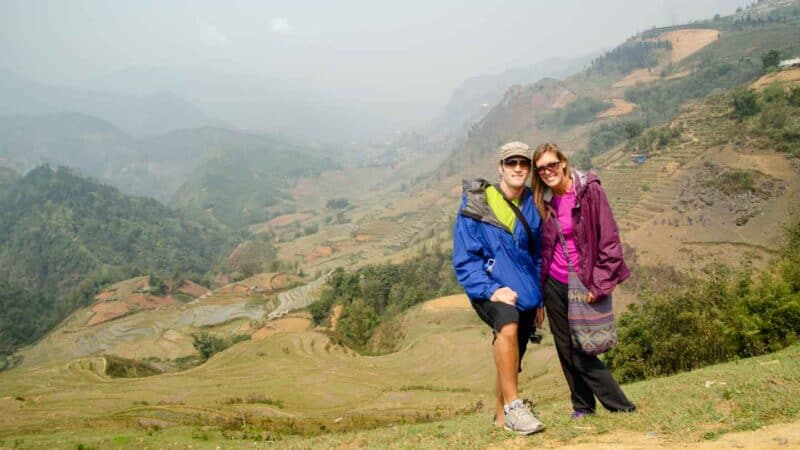
Trekking in Sapa Vietnam
Most people make the long voyage up here to do trekking in Sapa Vietnam, and rightfully so. The allure of walking through rural Vietnam through stunning terraced rice fields with local people.
It sounds like a bucket-list-worthy place, doesn’t it? It surely can be, but getting an authentic experience gets more challenging every year.
Multiday vs. Single Day Trekking trips from Sapa
One isn’t necessarily better or worse but may be a better option depending on the traveler and the experience they are looking for. Here, we have broken down what you could expect while trekking in Sapa, Vietnam, on a single-day hike or a multiday trek.
Trekking Day Trips from Sapa Town
Single-day trips to trek through the villages and rice terraces outside of Sapa are easy to arrange in Sapa or before you get there. This type of tour is better for those who would prefer to stay in a hotel rather than a homestay while trekking, aren’t up for long treks, or don’t have the time for a multi-day hike.
The downside of a single-day trek is that you don’t get as far from the town, and you will only get to go to some of the more visited and somewhat less authentic villages. Plus, overnighting in a homestay is a unique experience and gives better insight into local life.
However, this is a double-edged sword since trekking and homestays are the most popular activities in Sapa. They themselves are slowly or not so slowly changing the cultures that visitors are trying to see.
Pros:
- Shorter time commitment
- Less demanding physically
- Generally smaller or private groups
- More comfortable accommodation options
Cons:
- Slightly less authentic experience
- Less access to remote villages and landscapes
Multiday Sapa Trekking
These are best for the adventurous types who are looking to get out of the city and see a glimpse of what local life is like in rural northern Vietnam.
Pros:
- More authentic experiences
- Access to more remote areas of Sapa
- More immersed in local cultures
Cons:
Weather in Sapa Vietnam
Most people see pictures of Sapa and probably assume it’s always bright green rice terraces, but that’s not the case. Due to its northern location and high elevation, Sapa’s weather is drastically different and the city sees many changes seasonally.
Sapa Vietnam Dry Season & Monsoon (rainy) Season:
Dry Season: Traditionally, the driest months are from October until early to mid-April. Now that doesn’t mean it never rains, even during the dry months Sapa can get rain and is often humid with fog rolling over the mountains and hills.
During this time, historically, Sapa will have 8-15 days with some amount of rainfall and accumulate 30-80 mm (1.1-3.1″) of rain per month.
Rainy or Monsoon Season: Mid-April – Mid or End of September traditionally is the monsoon season in Sapa. However, in the past few years (2016 – 2019), we have seen a lot of volatility in what was once a very predictable cycle.
During this time, expect some rainfall just about every day and monthly accumulations of around 300-1000+ mm (11.1-31.1″) of rain. The 2017 & 2018 rainy seasons brought ten-year highs of rainfall with 1000-1500mm (31.1-59.0″) of rain per month.
Sapa Weather by month
December to February: These are the coldest months, with the average temperatures being around 13°C with highs close to 18°C and lows dropping to around 10°C. It does snow in Sapa, on average the city will see 1-4 snow days per year, however, 2017 and 2018 did not have any snow. If you are lucky, the rice terraces look stunning with a sprinkling of snow on them.
March to Mid-May: This is still part of the dry season with some of the hottest temperatures of the year, with average daily highs around 30° in April and a few degrees cooler in March and May. depending on the year, May could also be classified as the rainy season, with some years seeing as much rain as the following months. The second half of May will be getting pretty wet.
Our last visit was in March, and even though this should be one of the driest months, it was still very humid, so humid it broke one of our computers left inside a backpack in the hotel room.
Also, most evenings, a thick fog would roll in and cover the streets, making it hard to see more than 10 meters (30ft) in front of you; this is probably the foggiest place we have ever visited.
June to August: During this time of the year, it’s the rainy season in Sapa Vietnam. Temperatures cool off a few degrees, and rain increases dramatically. The pros of traveling during this season are that the rice fields will be at their peak. If you want to see bright green rice fields, this is the time to come.
Mid-September to December: September, much like May, can be rainy, especially at the beginning. By October, the rains have generally slowed but still have some rainy days.
Rice Terraces in Sapa
The climate in Sapa only allows for one rice crop per year, meaning the terraces aren’t always bright green. The best time to see the rice terraces at their peak is also the rainiest time of the year. No matter what time you visit, there is something to see, and here’s what to expect at each time of the year in Sapa.
December to April: During this time, the rice terraces are empty. They will be somewhat green from grasses growing around them, but where the rice actually grows, you will see still ponds of water – which can be quite nice.
April to May: Famers will be planting the rice in their fields and terraces. Some planting may happen as early as March and April.
June to September: The hills and terraces will be the bright green you might expect when you think of Sapa. Be prepared for rainstorms during this time of year. If we go back to Sapa, it would be during this time.
October-November: At the end of the season, the terraces will turn golden brown when it is time to harvest the rice. This is a great time to get photos of farmers harvesting their fields, largely by hand, and getting them ready for the following year.
The Culture of Sapa Vietnam
Sapa is renowned in Vietnam for the ethnic minorities who live there. It is these hill tribes that give the town its unique character and feel – everywhere you go, you see the rich cultural heritage.
In this respect, Sapa is unlike anywhere else in the country. This is really what makes it such a special place to visit. At the Sapa Market, for instance, you’ll come across locals from various tribes wearing traditional clothes and selling handmade artisanal goods. Every now and again, you may come across a wedding or local celebration.
While the stunning scenery is undoubtedly one of Sapa’s main draws, its intoxicating cultural makeup is what many people come for. Trekking to some of the nearby villages in Sapa that are scenically located amongst paddy fields or hugging hillsides is a must if you want to gain a greater insight into local heritage and traditions.
Alongside the numerous day trips and treks on offer, which take you to visit the hill tribes’ villages, visitors can also elect to stay in a homestay with one of the families. This is a rewarding experience as you get to make new friends and learn about the local culture at the same time.
While the Hmong and Dao people make up the majority of Sapa’s population, other ethnic minorities are present in the shape of the Tay, Giay, and Xa Pho, with each having their own unique characteristics. Most people in Sapa and the surrounding villages work in agriculture, so you’ll see lots of people working in the rice fields.
The hill tribes also produce some lovely hand-made ethnic clothes, textiles, and artisanal products. Purchasing some is a great way to support the local culture while coming away with a memento of Sapa Vietnam. At the sight of a sale, however, you may be surrounded by more vendors, and children will often approach you selling small items and trinkets.
In Sapa, it is possible to take a Hmong sewing class so you can learn how to reproduce the local textiles and clothes for which the town is renowned.
The History of Sapa Vietnam
Due to Sapa’s remote location amid the mountains, not much, if anything, is known about the first people to inhabit the area. Indeed, all that’s left of them are hundreds of petroglyphs – lines carved into rock; experts believe that these date to the 15th century.
While you can visit them when in Sapa, Vietnam, most of them have been worn down over the centuries by the weather and aren’t that impressive to look at.
The first groups to move into the area after these earlier inhabitants were the Hmong and Dao peoples; they are still the most prominent of the ethnic minorities in Sapa today. The Giay and Tay people also moved into the mountain range around this time. The fact that the more numerous lowland Vietnamese (the Kinh) didn’t colonize the area meant that the ethnic minorities’ traditions and cultures were preserved.
As the valleys and highlands around Sapa were so secluded, the town didn’t even appear on any maps until the French showed up in the late 1880s; even then, it was often under the name ‘Chapa’ due to how the French pronounced it. From then on, French influence only increased, and military parties and missionaries soon started showing up.
From 1891 onwards, the entire region was ruled by the French colonizers, who sometimes sent the military into Sapa to silence any dissent or resistance in what was a sensitive area due to its proximity to China. Over the following decades, French civilians and a military garrison moved into Sapa, changing the town’s look in the process.
Much of Sapa was destroyed in the hostilities that took place from the end of World War II until 1954; almost all of its colonial buildings were lost during this period. Vietnamese nationalists fighting for independence would target French buildings and personnel, while the French carried out bombing raids on the town in a bid to suppress the resistance.
Due to all the fighting, most of the population left Sapa. Only in the early 60s did the town come back to life again, as the new socialist government encouraged lowland Vietnamese to migrate to the highlands.
While the Vietnam War (or as they call it, the American War) and further wars against both Cambodia and China did not have much impact on Sapa, it wasn’t until 1993 that tourists began coming to see its wonderful sights, when the socialist government opened the country to international tourism.
Although, in recent years, Sapa has become increasingly touristy, it still has many authentic parts to it, and the scenery alone makes it worth a visit.
Related Article: Best Vietnam Destinations
Sapa Vietnam Basics | FAQs
Does Sapa have an ATM?: Yes, several
Is there Wifi in Sapa? Yes, our hotel had Wi-Fi, and our SIM card had service as well.
Helpful Sapa Tips
Book your tickets in advance for the train – The nicer cars fill up, especially around the weekends. On the way to Sapa, we were in the caboose, people sleeping on the bathroom floor, and a rat scampered through our cabin as we woke up in the morning.
Don’t overpay for the shuttle to/from Sapa – The fair price is 50,000 Dong per person. The drivers will start at 200,000+, but stick to your guns. They will eventually give in and then ask you not to tell the other passengers who didn’t negotiate as well as you.
Go to the Supermarket – The convenience stores in town are very overpriced. We walked every other day up to the supermarket across from the lake to get water, snacks, and bread. Their baguettes are very nice and only 5,000 dong.
Best time to visit Sapa -The best time, according to locals, is July-August, but that’s also the rainy season. Because of the climate, Sapa only gets one rice harvest, and if you don’t time it right, the picture-perfect fields of green rice may not be full. They are still pretty impressive, but it would be ridiculously pretty if they were bright green.
Restaurants in Sapa – Every restaurant in town is significantly more expensive than everywhere else in Vietnam. It was difficult to find a meal for under 100,000 dong ($5 USD), which I know in the rest of the country I can get fat for that much per day!
The worst part was that the food was bad, even for the elevated prices. I had a few meals that were actually decent, but it was very disappointing because I really liked the food in Vietnam overall.
Don’t forget to Pin me for later!
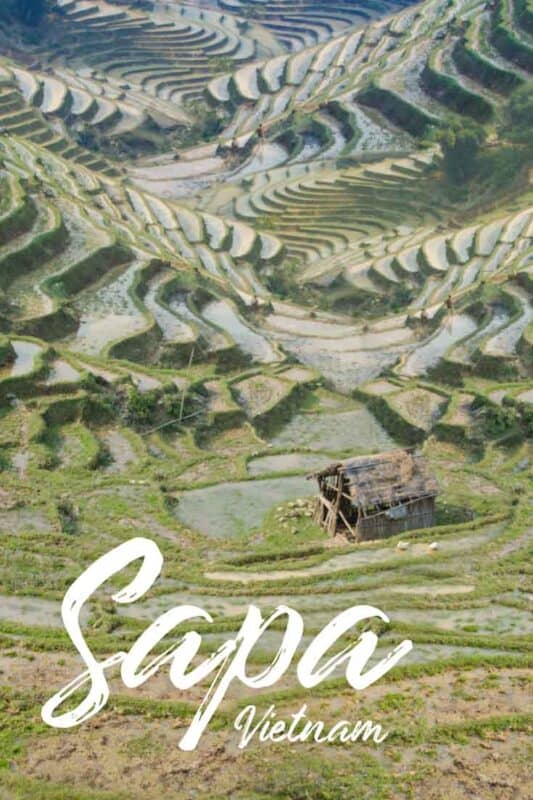
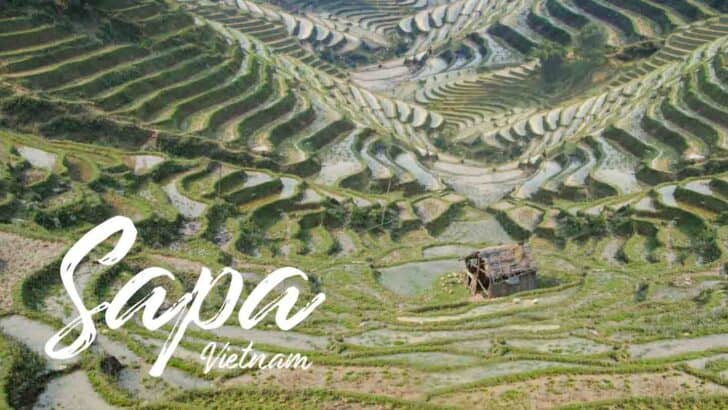
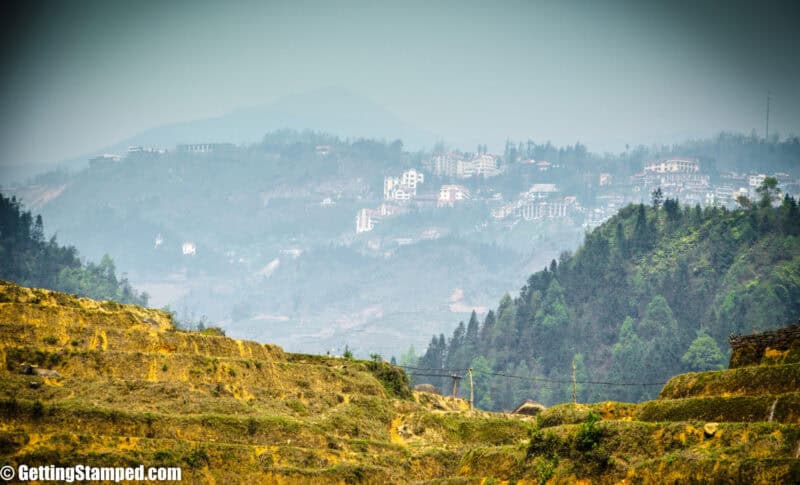
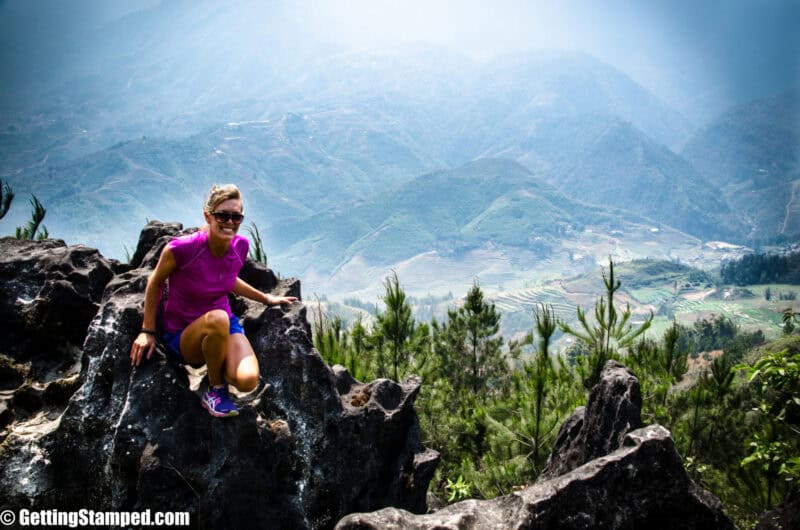
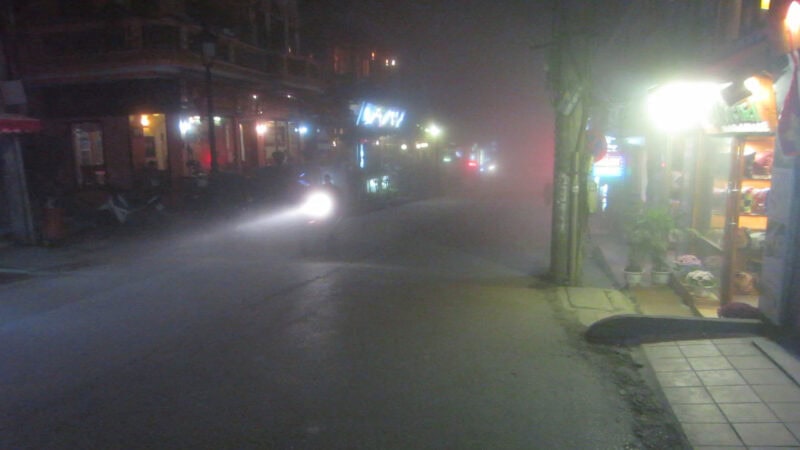
Jose Joven
Thursday 18th of April 2019
Thanks for the article. I'm planning on visiting SaPa/LaoCai/BacHa area next March. One bummer, we are not trekkers anymore, at 70 and 74 neither one of us want to spend an hour...or a day humping through the mountains. We will also be staying in a guesthouse or hotel instead of a homestay.
That said, is it possible to see views of the rice terraces from town or a short taxi ride away? Something like the picture featured above with the rice terraces falling down the valley with the old house.
Thank you again for the informative essay.
Adam
Friday 3rd of May 2019
You can still see some rice terraces without a long trek. You could take a taxi to Cat Cat Village to see a bit of culture and some waterfalls. A short ride outside the town should bring you to some rice terraces. When you get to town I would talk with a tour operator and tell them what you'd like to see and I am sure they would know some good places to bring you - just be sure to negotiate on prices, in Vietnam, they tend to start high on prices. Safe Travels!
Sandr Ramos
Monday 6th of November 2017
It's been very helpful your article, thank you! We are planning a trip to Vietnam next year, would you recommend us to visit Sapa by the end of October? Are rice terraces ,green? Thank you
Adam
Tuesday 7th of November 2017
There is only one rice season per year in Sapa and according to locals, the peak green season is in the mid to late summer months July-August. We haven't visited in October, but the fields may be cleared or they will golden brown by then. Our last visit was in February and the fields had not been planted yet and it was still pretty. The pictures in this article are from January for reference. I am not sure there is a bad time to visit Sapa, but if you must see green rice fields, the summer months are your better bet.
Maria Scarinci
Monday 30th of January 2017
Thanks for the tips on Sapa...we are going for 10 days in May to Vietnam and we were organising to stay in Hoi An for at least 4 days....but we would love to go somewhere else....our goal is to experience their culture, beautiful people and food as well as relaxing. Our flights are in and out of HCM and we don't want to spend time in this hectic city...would you suggest another place to spend the rest of our 10 days? Thanks!
Adam
Tuesday 31st of January 2017
Hue is nice just a little bit north of Danang. We spent 2-3 nights there checking out the old citadel. There is also the marble mountain nearby. Or if you are more adventurous maybe check out the world's largest cave Hang Sơn Đoòng, we haven't been but it's at the top of our Vietnam list! Have a great trip!
Marianne Heilman
Monday 21st of November 2016
Just want to give you a heads up and any other travelers who read your blog before they go to Sa Pa... there's a local bus that's only 28,000 dong per person. The other taxi and minibus drivers will try and get you right off the train before you find out about the local bus. Thankfully we researched before heading there and knew not to hire one of those guys. The local bus is parked outside of the train station to the left. It's a red, yellow and white bus. The bus driver was waiting outside for anyone coming from the trains. We were just there a few weeks ago.
Hannah
Saturday 26th of November 2016
Thank you so much for letting us know!
Jo (The Blonde)
Monday 4th of April 2016
I did the trek, too. The first day was so hot and humid that we sweated like there was not tomorrow. The second day was so foggy! It was just a wall of fog and we couldn't see anything. We slept in the local village and it was the coolest experience ever! I love your photos. Really impressive.